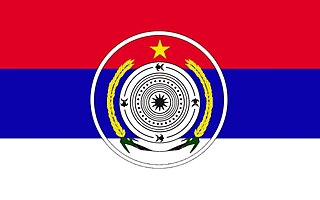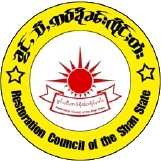
The Mon language is an Austroasiatic language spoken by the Mon people. Mon, like the related Khmer language, but unlike most languages in mainland Southeast Asia, is not tonal. The Mon language is a recognised indigenous language in Myanmar as well as a recognised indigenous language of Thailand.

The Karen National Union is a political organisation with an armed wing, the Karen National Liberation Army (KNLA), that claims to represent the Karen people of Myanmar. It operates in mountainous eastern Myanmar and has underground networks in other areas of Myanmar where Karen people live as a minority group.

The Karen National Liberation Army is the military branch of the Karen National Union (KNU), which campaigns for the self-determination of the Karen people of Myanmar. The KNLA has been fighting the Burmese government since 1960s as part of the Karen conflict, which has been ongoing since 1949.

The Kachin Independence Army is a non-state armed group and the military wing of the Kachin Independence Organization (KIO), a political group of ethnic Kachins in Northern Myanmar. The Kachins are a coalition of six tribes whose homeland encompasses territory in China's Yunnan, Northeast India and Kachin State in Myanmar.

Insurgencies have been ongoing in Myanmar since 1948, the year the country, then known as Burma, gained independence from the United Kingdom. The conflict has largely been ethnic-based, with several ethnic armed groups fighting Myanmar's armed forces, the Tatmadaw, for self-determination. Despite numerous ceasefires and the creation of autonomous self-administered zones in 2008, many armed groups continue to call for independence, increased autonomy, or the federalisation of the country. The conflict is the world's longest ongoing civil war, having spanned more than seven decades.

The Kayan New Land Party is a political party in Myanmar. Its armed wing is Kayan New Land Army.
Ceasefires in Myanmar have been heavily utilized by the Burmese government as a policy to contain ethnic rebel groups and create tentative truces. The first ceasefire was arranged by the State Law and Order Restoration Council in 1989, specifically spearheaded by Khin Nyunt, then the Chief of Military Intelligence, with the Kokang-led National Democratic Alliance Army, which had recently split from the Communist Party of Burma due to internal conflicts.

The Karen conflict is an armed conflict in Kayin State, Myanmar. It is part of the wider internal conflict in Myanmar between the military government and various minority groups. Karen nationalists have been fighting for an independent state, known as Kawthoolei, since 1949. The Karen National Union (KNU) and its Karen National Liberation Army (KNLA) are the most prominent Karen rebel groups. Hundreds of thousands of civilians have been displaced by the conflict, many of whom fled to neighbouring Thailand and survive in refugee camps.

The United Nationalities Federal Council is a coalition of five opposition groups in Myanmar. In 2011, the council was formed by 11 opposition groups that campaigns for the rights of various ethnic minorities in Myanmar. Six of the UNFC's members have successfully made or are in the process of making peace negotiations and permanent ceasefire agreements with the government. The group's armed wing is the Federal Union Army (FUA).

The New Mon State Party (NMSP) is an opposition party in Myanmar. Its armed wing, the Mon National Liberation Army (MNLA), has fought the government of Myanmar since 1949, but under different names. The NMSP has attempted many times unsuccessfully to push for constitutional and political reforms through the government sponsored National Convention. The NMSP had signed a ceasefire pact with the government in 1995 but the pact turned invalid when the party refused to accept to transform itself into a border guard unit.

The Mon National Liberation Army is a Mon insurgent group in Myanmar (Burma). It is the armed wing of the New Mon State Party (NMSP), and has been fighting government forces since 1949, though under different names. The NMSP signed the Nationwide Ceasefire Agreement (NCA) on 15 October 2015 with several other insurgent groups and the government of Myanmar.

The Restoration Council of Shan State is a Shan political organisation in Shan State, Myanmar, founded in 1996 by Shan military leader Yawd Serk. Its armed wing, the Shan State Army – South (SSA–S), is signatory to the Nationwide Ceasefire Agreement with the government of Myanmar. Following the 1 February 2021 coup d'état, the Tatmadaw violated the ceasefire agreement by attacking the camps of the RCSS in Hsipaw Township.
The Nationwide Ceasefire Agreement (NCA), officially the Nationwide Ceasefire Agreement between the Government of the Republic of the Union of Myanmar and the Ethnic Armed Organisations, was a landmark ceasefire agreement between the government of Myanmar and representatives of various ethnic insurgent groups, officially known as "ethnic armed organisations" (EAOs) by the government. The draft was agreed upon by a majority of the invited parties on 31 March 2015, and the agreement was signed by President Thein Sein on 15 October 2015. The signing was witnessed by observers and delegates from the United Nations, the United Kingdom, Norway, Japan and the United States. A ceremony is held by the government annually on the anniversary of the signing of the agreement.
The Karen–Mon conflict is a series of armed clashes between the ethnic rebel armies of the Karen and Mon peoples. The Karen National Liberation Army and the Mon National Liberation Army have clashed sporadically since 1988, mostly around the Myanmar–Thailand border at Three Pagodas Pass.

Pe Thein Zar was a Mon student leader, lawyer, revolutionary, and writer who was imprisoned for seven years for his activism. He earned a BA (History) degree from Rangoon University.

The Myanmar civil war, also called the Burmese Spring Revolution, Burmese civil war or People's Defensive War, is an ongoing civil war following Myanmar's long-running insurgencies, which escalated significantly in response to the 2021 military coup d'état and the subsequent violent crackdown on anti-coup protests. The exiled National Unity Government and major ethnic armed organisations repudiated the 2008 Constitution and called instead for a democratic federal state. Besides engaging this rebel alliance, the junta also contends with other anti-junta forces in areas under its control. Hannah Beech of The New York Times observed the insurgents are apportioned into hundreds of armed groups scattered across the country.

The New Mon State Party is a splinter group of the Mon National Liberation Army.
The Mon National Defence Army was a splinter group of the Mon National Liberation Army in Myanmar formed in retaliation for the New Mon State Party entering a ceasefire with the State Peace and Development Council. The MNDA eventually united with another breakaway MNLA faction led by Nai Pan Nyunt on November 29, 2001 to form the Monland Restoration Army.











